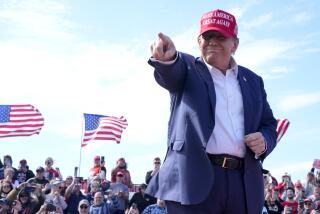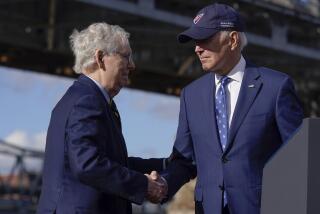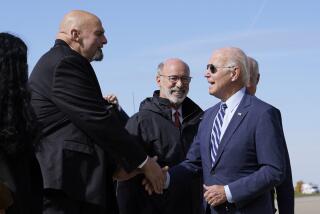Trump takes pitch for big infrastructure program to Ohio, despite dismal odds in GOP Congress

President Trump renewed his call for more spending on America’s infrastructure on Thursday in a meandering speech that, by his frequent departures from the topic, helped explain why he hasn’t gotten his party in Congress behind him for an extensive rebuilding of the nation’s public works.
In remarks at a job training site in Ohio against a backdrop of union workers in hard hats, Trump boasted of the $21 billion for infrastructure in the recently enacted government spending bill — money he had ignored when he grudgingly signed the measure on Friday. He then hopscotched across a host of unrelated issues and set pieces of his campaign speeches, with partisan asides against the Democrats whose votes he’d need for any infrastructure legislation.
“We’re going to get this infrastructure going,” Trump said at one point, a passage bracketed by mentions of his proposed border wall, North Korea, ISIS and the “gift from heaven” of finding so many vacant federal judgeships to fill.
At one point, the president insisted that Democrats so far had blocked his proposed $1.5-trillion infrastructure spending initiative because they didn’t want to “give him any more wins.” Yet in the same sentence, he said further action would have to wait until after the November election, though even Republicans expect that more Democrats will be elected to Congress, not fewer.
Trump’s glancing references did little to suggest that infrastructure ranks high on his list of desired accomplishments, just as his haphazard treatment of the issue in his first year did.
As a candidate, Trump made talk of a bold building program a signature issue, to help him reach blue-collar workers with promises of restoring industries, particularly in Midwestern states like Ohio. He spoke of federal funds for transportation, broadband internet access and water and electrical programs. He varied on how he would pay for it, suggesting a higher gas tax, energy production revenue or savings in the tax plan.
But as president, he has said — and he restated at the Cleveland-area facility — that he advocates minimal federal spending, and offsetting the cost with cuts to existing infrastructure programs. He also is pushing for cash-strapped state and local governments to put up the vast majority of the $1.5-trillion cost, and suggested private businesses would invest. Most analysts consider that impractical.
Trump’s appearance in Ohio was his first public event since he reluctantly signed the $1.3-trillion government spending plan at the White House on Friday, a period during which news was dominated by accusations leveled by two women who claim past sexual relationships with him.
While Trump at the Friday event warned Congress that he “would never sign another bill like this again,” and blamed much of its nonmilitary spending on wasteful Democrats, lawmakers from both parties embraced the infrastructure spending and claimed credit for it. Congress tripled a $500-million program of transportation grants to state and local governments, which Trump had proposed canceling.
Still, Trump administration officials also bragged about the bill’s total $21 billion for infrastructure in a telephone call Wednesday with reporters, casting it as a down payment on Trump’s own proposals.
The reality is that few in either party, or among interest groups, are predicting any big infrastructure push this year.
“His plan is going nowhere. I don’t think anybody thinks we’re going to get anything between now and the election,” said a person steeped in the infrastructure negotiations, who requested anonymity in order to avoid angering the parties involved.
Ironically for Trump, a Democratic takeover of the House in November’s election would boost the odds of more infrastructure funding, the person said — although not necessarily in the ways the president has proposed.
Others suggested that Republicans as well as Democrats recognize the appeal of infrastructure spending, although they disagree on the details. The big problem: Congress and the president in recent months have signed off on adding an estimated $2.8 trillion over 10 years to the already high federal debt, counting the tax cut plan and the fiscal 2018 government spending measure.
“The biggest problem right now is there’s no money left,” said Marcia Hale, president of Building America’s Future, a bipartisan group advocating for infrastructure spending, who once worked in the Clinton administration.
Trump’s proposal to shift the costs to local and state governments is seen as unworkable because they already are overwhelmed by day-to-day needs. (The Trump-approved tax plan also provided a disincentive to raising taxes, since sharp limits were placed on how much could be deducted from federal tax returns for residents’ state and local taxes.)
“Cities and states don’t have that money. It’s just not there,” Hale said. “You can talk about it all you want, but until someone figures out how we’re going to pay for this …”
Earlier efforts by the White House to highlight Trump’s infrastructure plan have been repeatedly overshadowed, so much so that “infrastructure week” has become a sardonic punchline for any period in which the administration is convulsed by unrelated chaos.
Over the last year, weeks in which the administration planned to highlight infrastructure have been upended by controversies including Trump’s response to the white supremacists’ protests in Charlottesville, Va., in which he blamed civil rights protesters and neo-Nazis equally for the deadly violence; the Florida school shooting last month; the resignation of an aide accused of marital abuse; and the ongoing Russia investigation.
Trump administration officials maintain a public optimism. A senior administration official, speaking to reporters, said: “We never anticipated this was going to be a quick or easy process. And the president just absolutely is in this for the long haul.”
The odds of pieces of Trump’s plan passing this year “are very, very high,” the official added. “Will we get the entire bill through this year? That is more of a stretch.”
Republican leaders in the Senate, however, are signaling that they don’t have any intention of putting an infrastructure bill on the floor this year.
“There’s an acknowledgment of the need here,” said Jacob Leibenluft, a former Obama administration official. “The problem is that the need hasn’t been met by any of the policy details that come from the administration or from Congress. It doesn’t match up with this big national need.”
For more on politics from Cathleen Decker »
Twitter: @cathleendecker
christi.parsons@latimes.com
Twitter: @cparsons
ALSO:
Updates on California politics
More to Read
Get the L.A. Times Politics newsletter
Deeply reported insights into legislation, politics and policy from Sacramento, Washington and beyond. In your inbox three times per week.
You may occasionally receive promotional content from the Los Angeles Times.








